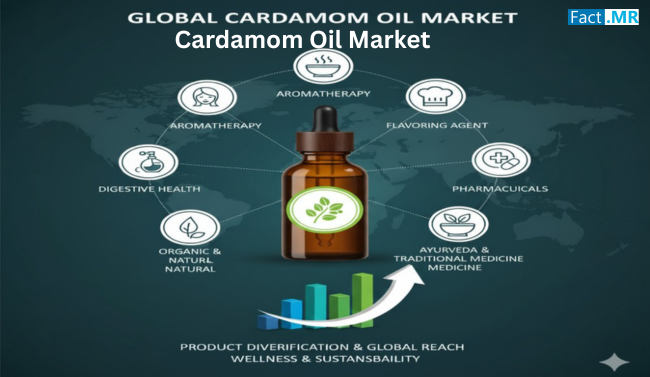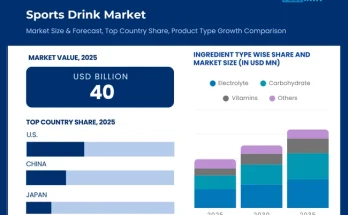The global cardamom oil market has witnessed steady growth as consumers increasingly prefer natural and versatile products for health, wellness, food, and personal care. Extracted from cardamom seeds, cardamom oil is known for its aromatic fragrance, therapeutic properties, and culinary versatility. Its applications span aromatherapy, cosmetics, pharmaceuticals, toiletries, food and beverages, and cleaning products. With rising interest in natural oils and essential oils, cardamom oil has become a sought-after ingredient in multiple industries.
This article provides a detailed analysis of the cardamom oil market, highlighting growth drivers, consumer trends, regional insights, competitive landscape, and future opportunities.
Market Overview
Cardamom oil is obtained from Elettaria and Amomum plants, and it contains essential components such as methyl eugenol, pinene, sabinene, linalyl acetate, geraniol, nerol, and citronellol. The oil’s rich composition offers therapeutic, cosmetic, and flavoring benefits. In cosmetics, it functions as a natural fragrance and skin care ingredient; in food and beverages, it adds unique flavor and aroma; in aromatherapy, it is used for stress relief and relaxation.
The market is categorized by source type (natural and organic), form type (absolute, concentrates, blends), application (therapeutics, aromatherapy, cosmetics, food & beverages, toiletries, fragrances, cleaning), and distribution channel (modern trade, franchise outlets, specialty stores, online). Each segment is contributing to the growing global demand.
Key Market Drivers
- Increasing Use in Aromatherapy and Therapeutics
Cardamom oil is valued for its calming and revitalizing properties, making it popular in aromatherapy and holistic health practices. Its ability to relieve stress, improve mental clarity, and support digestive health has increased adoption in wellness routines.
- Rising Popularity in Cosmetics and Personal Care
Cardamom oil is widely incorporated in cosmetics, toiletries, and skincare products for its fragrance, antioxidant properties, and antibacterial effects. Manufacturers are leveraging the oil in soaps, shampoos, lotions, creams, and perfumes to appeal to consumers seeking natural and chemical-free products.
- Growth in the Food and Beverage Industry
Cardamom oil is a key flavoring agent in beverages, desserts, and gourmet foods. Its unique taste and aroma enhance products such as tea, coffee, confectionery, sauces, and baked goods. The trend of premium and exotic flavors has bolstered demand in this sector.
- Adoption of Organic and Natural Products
Consumers are increasingly shifting toward organic, non-GMO, and chemical-free products. Organic cardamom oil is preferred for its purity and sustainable sourcing practices, aligning with the global movement toward eco-friendly and healthy living.
- Technological Advancements in Extraction
Modern extraction methods such as cold pressing and steam distillation maintain the oil’s potency and aroma while improving efficiency. These technologies enable manufacturers to deliver high-quality products at scale to meet global demand.
Market Challenges
- Adulteration and Quality Concerns
The presence of adulterated or synthetic oils in the market can compromise quality and consumer trust. Ensuring authenticity and proper labeling remains a key challenge for producers and regulators.
- High Production Costs
Producing high-quality cardamom oil requires careful sourcing, cultivation, and processing. Costs associated with extraction, certification, and compliance can be high, especially for organic and premium-grade oils.
- Supply Chain Limitations
Cardamom oil production is geographically concentrated, which can affect supply stability. Fluctuations in crop yield due to climate conditions and agricultural constraints may impact availability and pricing.
- Regulatory Compliance
Different countries enforce varying regulations for natural oils in cosmetics, therapeutics, and food applications. Navigating complex compliance requirements can be challenging for global manufacturers.
Regional Insights
Europe
Europe represents the fastest-growing market for cardamom oil, driven by high disposable income, consumer preference for natural products, and strong end-user industries in cosmetics, pharmaceuticals, and food & beverages. The region’s emphasis on organic certifications and sustainable sourcing further supports growth.
North America
North America shows moderate growth due to rising awareness of natural oils, aromatherapy, and personal care trends. The market benefits from e-commerce and retail channels, facilitating easier access to premium cardamom oil products.
Asia-Pacific
Asia-Pacific is experiencing steady demand, particularly in India and Southeast Asia, where cardamom oil is a traditional ingredient in cuisine, herbal remedies, and wellness products. Increasing urbanization and lifestyle changes drive adoption in modern personal care and food applications.
Middle East & Africa
The Middle East & Africa market is expanding due to traditional culinary uses, growing cosmetic and personal care industries, and rising interest in natural therapeutic products. Regional production in Africa contributes to supply for global markets.
Consumer Trends
- Natural and Organic Products: Strong demand for chemical-free, organic, and sustainably sourced cardamom oil.
- Aromatherapy and Wellness: Adoption in essential oil diffusers, massage oils, and therapeutic applications.
- Premium Cosmetics: Consumers favor high-quality cardamom oil in skincare, haircare, and fragrance products.
- Food and Beverage Innovation: Use of exotic and aromatic flavors in gourmet and health-focused products.
- E-Commerce Growth: Online sales channels enable direct-to-consumer access and subscription models.
Competitive Landscape
Key players in the cardamom oil market include:
- Green Fields Oil Factory
- Plant Therapy Essential Oils
- Lionel Hitchen Essential Oils
- Aromaaz International
- IL Health and Beauty Natural Oils Co. Inc.
- Aksuvital
- Shaanxi Guanjie Technology Co.
- Natures Natural India
- Young Living Essential Oils
- Greenleaf Extractions Pvt. Ltd.
- Biolandes
- The Lebermuth Company
These companies focus on product innovation, certifications, sustainable sourcing, and expanding distribution channels to enhance market share.
Opportunities for New Entrants
New entrants can capture market opportunities by:
- Introducing organic, cold-pressed, or blended cardamom oils
- Targeting aromatherapy, premium cosmetics, and gourmet food applications
- Leveraging e-commerce and direct-to-consumer strategies
- Adopting sustainable cultivation and ethical sourcing practices
- Developing innovative packaging and value-added products
Focus on quality, authenticity, and consumer engagement is crucial for success.
Future Outlook
The cardamom oil market is expected to maintain steady growth due to increasing consumer preference for natural, organic, and multifunctional products. Key growth drivers for the future include:
- Expansion in cosmetics, personal care, and aromatherapy segments
- Increased adoption in functional and gourmet food applications
- Technological advancements in extraction and production
- Growth of e-commerce and global distribution channels
- Rising focus on sustainability and ethical sourcing
The market presents long-term opportunities for manufacturers that balance innovation, quality, and consumer awareness.
Conclusion
Cardamom oil has become a valuable ingredient in cosmetics, personal care, aromatherapy, and food industries due to its aromatic, therapeutic, and culinary properties. The market is fueled by growing awareness of natural and organic products, premiumization, and lifestyle changes. While challenges such as adulteration, production costs, and regulatory compliance exist, the growing demand in aromatherapy, food, and personal care provides significant opportunities. Companies that emphasize quality, innovation, sustainability, and strong consumer engagement are well-positioned to succeed in the expanding global cardamom oil market.



